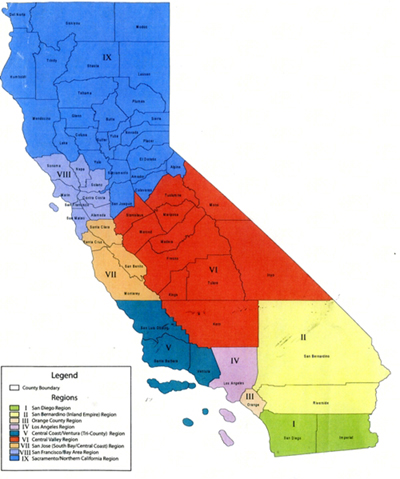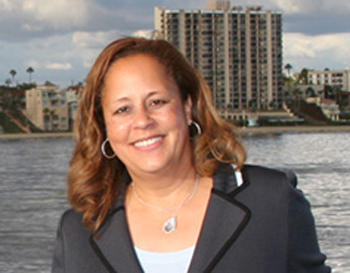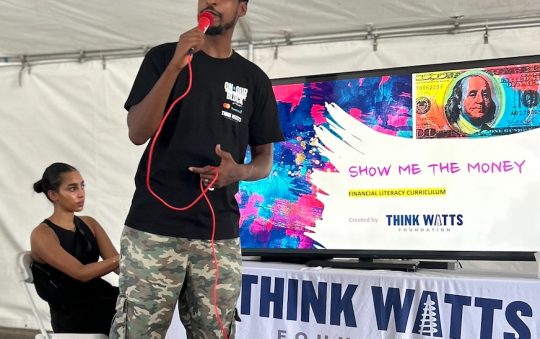 ”
”
State redistricting map with 10 regions.
Congresswoman Maxine Waters (CA-35)
Congresswoman Barbara Lee (CA-9)

Congresswoman Laura Richardson (CA-37)
Congresswoman Karen Bass (CA-33)
Understanding redistricting is of vital importance to members of the community especially those residents that are most impacted by any resultant changes in district maps of their representatives.
By Yussuf J. Simmonds
Sentinel Managing Editor
Samuel Richard, Sentinel Contributing Editor
Every ten years, the entire country undergoes a census count, mandated by law, to ascertain an up-to-date count of its population. In the most recent count, California retained the number one position having the largest population in the country. Armed with that information, California, along with the rest of the states, has to re-configure four category of legislative districts in accordance with the new census numbers: assembly, state senate, board of equalization and congressional districts.
To accomplish this, the state has been divided into ten regions and it has empowered an independent commission consisting of 14 members called the California Citizens Redistricting Commission (CCRC) to gather information via public input hearings in order to assist the body in re-drawing the districts equitably–so that each legislative district, per the four categories, has an equal number of people and thereby ensuring equal representative.
The commission started meeting in January and is presently working on creating new maps for 80 state assembly districts, 40 Senate districts, and four Board of Equalization districts, and 53 congressional districts. Using 2010 Census data as a basis, the commission is aiming to have certain amounts of people in the districts, according to media reports.
The commission was formed as a result of the 2008 passage of Proposition 11, which took the power to redraw boundaries from lawmakers and handed them to citizens, as the name suggests: ‘…. Citizens Redistricting Commission.’ As an independent body, the CCRC is committed to re-drawing fair districts that reflect the best interests of the people, according to their rules and regulations, with public input and without ‘official interference.’
Congressional districts can also be redrawn due to the passage of Proposition 20 in 2010. This is the first time in California’s history that citizens have been responsible for creating congressional and state legislative districts.
“We’re having public input hearings where we’re asking the public to get engaged in the process of participating with this effort,” M. Andre Parvenu, one of the commissioners, recently told the L.A. Sentinel. “… The effort is to assist us in defining communities of interest.”
According to the public interest notice, ‘…Public participation in drawing these districts is critical to ensuring that communities have the strongest voice possible to express their preferences. When voters with similar interests are drawn into a district together, their voices multiply giving them a greater opportunity to express their views, elect candidates of their choice and hold their leaders accountable…’
And it is important that the communities (of interest) understand how the lack of participation in the process could negatively impact their right to equal representation of their own choosing. The boundaries of the districts can make the difference between empowering and maximizing voters’ voices or minimizing and muting those voices.
“We’re on a fast track to get this job done, and we’re depending on the public to attend these input hearings so they can assist us in determining where these boundaries are going to be drawn,” Parvenu said. “We want to have this in place before the next election cycle which is 2012.”
Congresswoman Karen Bass (CA-33) said, “I think it (redistricting) has the potential to negatively affect the African-American community because there is the delusion that African Americans no longer live in the greater Los Angeles area. But in fact, if you compare the African American population in the state of California, ten years ago to now, there has not been a dramatic reduction in their numbers. We might live different places now but there’s not a dramatic reduction. So I think that it’s critical that we maintain African-American representation. On a congressional level, there are 53 members in the California delegation; there are only four African-Americans (Reps. Maxine Waters, Barbara Lee, Laura Richardson and Bass)…four out of 53. I think it would be very problematic and very negative to lose any of the representation that we have currently.”
The Sentinel has learned that two of the three African American congressional districts may have decreased by as much as approximately 60,000 since the 2000-census and that could be devastating for California’s African American representation in the Congress. In addition, assembly districts 48 and 51 may also become casualties of redistricting relative to the Black community.
One of the other issues Parvenu raised was about the method used in (under) counting prison and jail inmates who obviously happen to be NOT where they normally reside during the census count. In addition, it is statistically estimated that about 90 percent of the incarcerated inmates are expected to return to society.
Assemblyman Mike Davis (A-48) issued a statement about the approval of AB 420 which stated in part, ” …Currently, inmates are counted for redistricting purposes wherever they are found, rather than based on their last known residence. Under this system, inmates from Los Angeles who are incarcerated in San Quentin are counted along with Marin County, rather than L.A. County residents. This has the effect of disenfranchising California’s African-American and Latino communities by diluting their voting strength …. By counting incarcerated individuals in districts far removed from their home communities, those communities are being deprived of the political representation to which they are entitled. AB 420 not only remedies the counting of large populations in the wrong places, it brings the California redistricting process in line with the basic principles of democracy…”
Paul McKaskle, who has significant knowledge about redistricting, talked about why redistricting is important to the average person: “It has a lot of impact ultimately on the kinds of laws that are passed, because the Legislature is supposed to represent the people.”
“But I think one the slogans used was that the Legislature was choosing the constituents rather than the constituents choosing the Legislature,” said McKaskle, a retired professor from the University of San Francisco who addressed redistricting issues as a staff member at the California Supreme Court.
“This is history … We have an opportunity to create a process that the rest of the nation may want to copy or duplicate at some point,” Parvenu said.
Parvenu talked about what this means for African Americans.
“It’s an opportunity to speak up and be represented and to be a part of this historic process,” he said. “This is an opportunity to take control or … take a proactive role in determining where your community of interest is.”
This is the opportunity to express one united opinion about an issue that affects you directly in your neighborhood, he said.
He later added: “This is an opportunity not to be silent and to make certain that you’re affiliated with your neighbors so that, when the time comes, you have one representative to voice what your concerns are as opposed to having scattered representatives where you have an assembly person here, a senator there, a congressman there … This is an opportunity to make certain that your community has one unified and solid voice.”
Citizens wishing to provide testimony to the Commission can learn more about how to effectively present information by going to www.wedrawthelines.ca.gov http://www.wedrawthelines.ca.gov/. To assist you in providing your presentation, we have developed a “Toolkit” which you will find on the home page under “Upcoming Events.”
Draft maps are expected to be released June 10, and final maps are supposed to be turned in to the California secretary of state by Aug. 15.






